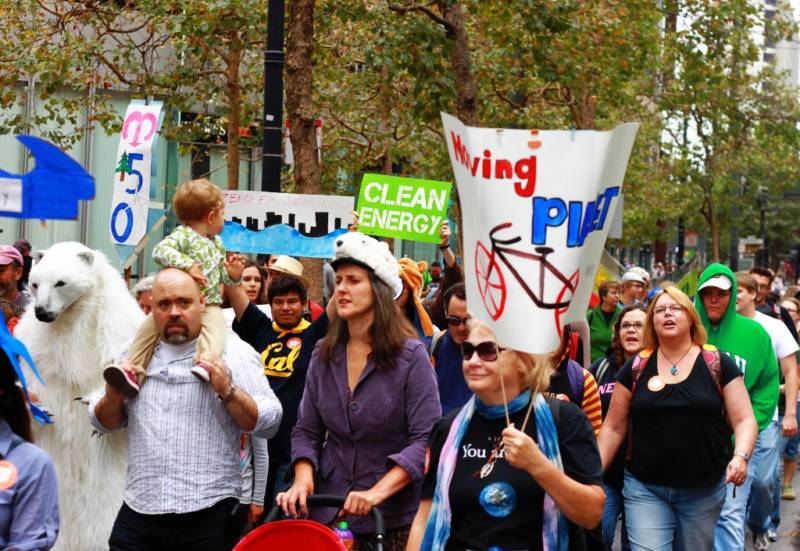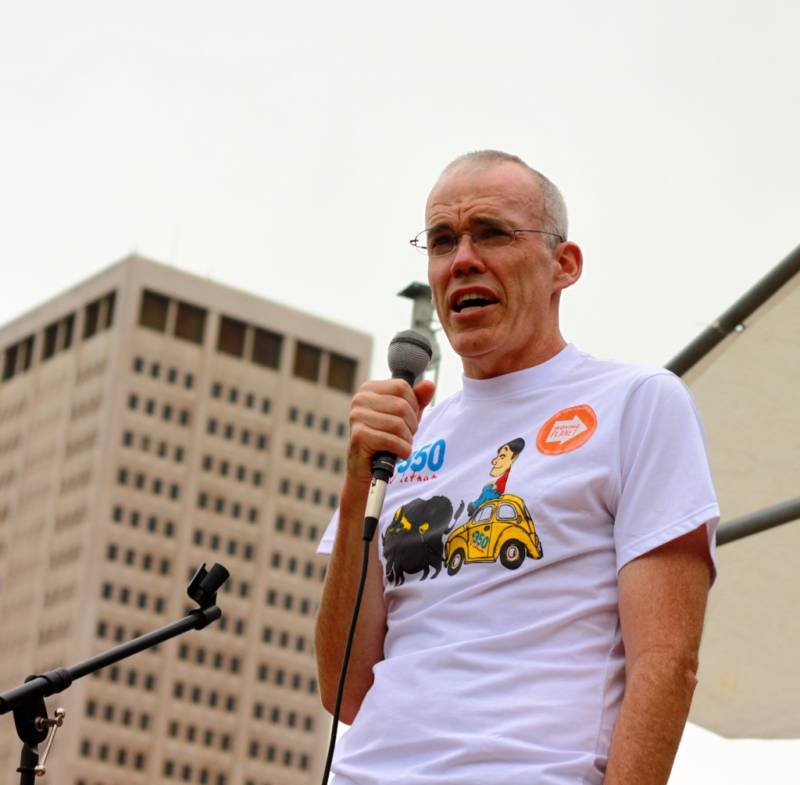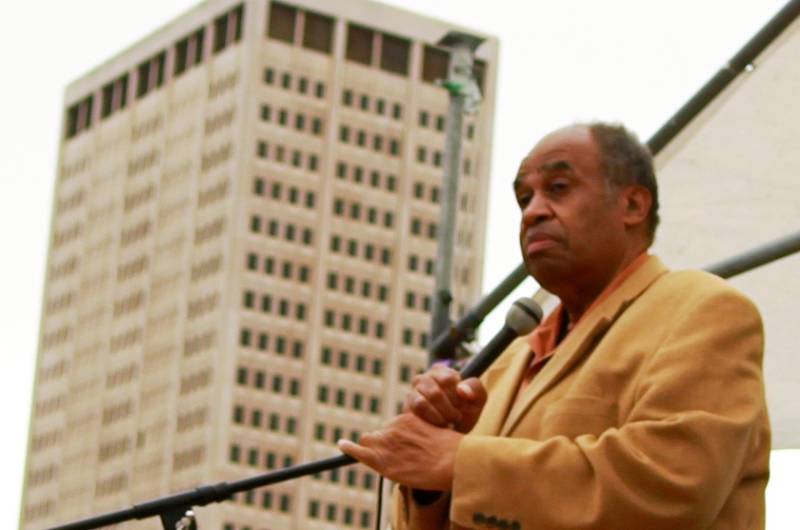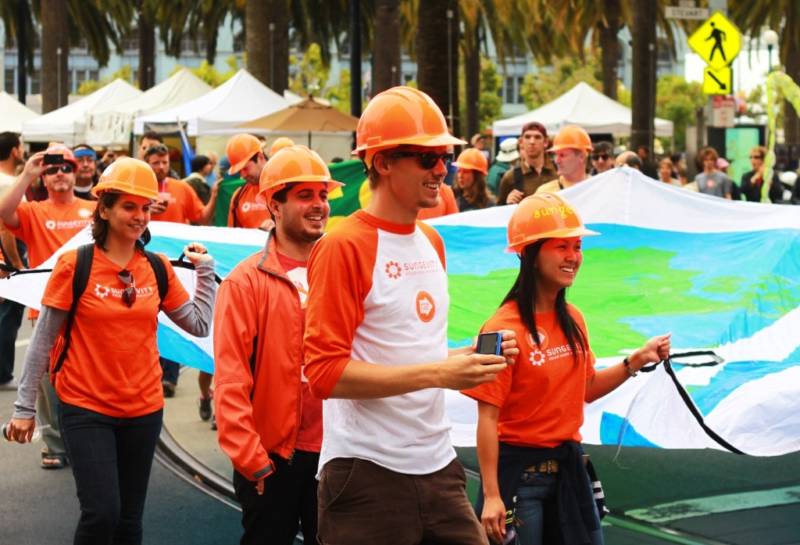Organizers call San Francisco “flagship” event for worldwide campaign

About a thousand people marched in San Francisco on Saturday, chanting slogans, carrying signs and wearing costumes. But unlike many demonstrations that frequent the City by the Bay, the Moving Planet rally was one of hundreds around the world, calling for action and awareness to halt global climate change.
Organized by 350.org, the non-profit founded by author and activist Bill McKibben, the San Francisco rally brought together some predictable allies, such as the Sierra Club, Greenpeace and the Berkeley-based Ecology Center, but it also included groups with broader aims, such as the National Organization for Women, Food Not Bombs and 100,000 Poets for Peace. McKibben’s group is devoted to reducing carbon dioxide in the Earth’s atmosphere to 350 parts per million (from the current 390 ppm), a number that some scientists estimate could stave off catastrophic effects of climate change.
“Every country on Earth — except for probably, North Korea — is having rallies around this wonky data point, 350 parts per million CO2,” said McKibben in an interview after addressing the San Francisco gathering.

In the absence of national climate change legislation, McKibben told the crowd, it’s important to “put our bodies on the line.” The Vermont-based activist is one of about 1,200 people that was arrested August 20 for protesting in front of the White House the proposed construction of the Keystone XL pipeline, which would bring crude oil from Alberta, Canada to Texas.
Michael Brune, President of the national Sierra Club noted that his organization was the first to create “blue-green” alliances between environmental and labor groups.
“What we’re trying to do is find a way to make this an issue that brings us together, that doesn’t divide folks, so this doesn’t punish one industry and reward another,” said Brune in a separate interview.
Brune added that the Sierra Club is working with clean technology companies to ramp up renewable energy. “We firmly believe the road to a clean energy future is one that will make our country more economically resilient,” he said.

Another focus of the afternoon rally was the connection to environmental justice, the concept that poor communities and ethnic minorities are disproportionately affected by pollution of all types. Carl Anthony, founder of Urban Habitat, one of the nation’s oldest environmental justice organizations, spoke to an energetic crowd packed into Civic Center Plaza. He emphasized that people, not just polar bears, are affected by climate change.
“Global warming is a climate justice issue,” he told the rally. “The people of color, the poor people, the indigenous people will bear the burden of climate change, even though they, less than anyone else, are responsible for our CO2 emissions.”
He continued, “This means that any solution we come up with for climate change must also be a solution for social and racial justice.”
“We have the opportunity in California, to take money away from suburban sprawl…to rebuild a public transportation system that works for poor people as well as rich people,” Anthony said, citing the Sustainable Communities legislation that would redirect $218 billion to rebuild public transportation.
Many people took public transit to the day’s event. Cassie Barr rode BART to the rally from Oakland with her six-year-old son, Philip. She said she wanted to make a statement that people should do more to avert climate change and that she supports an outright tax on carbon emissions. “I think it’s the only way to get businesses — corporations — serious about lowering their CO2 levels,” said Barr.
Jordan Pacheco also took BART from Moraga with his five-year-old daughter, Macy, “…because this is her planet too.” Pacheco works for the solar panel installation company Sungevity, on the firm’s design and engineering team.
In the future, he said, “I would like to see a more openness to any kind of alternative energy, whether its solar, wind, anything. I think the politics have taken over to the point where there’s no common sense anymore.”

Bill Carney, president of Sustainable San Rafael helped to organize participation from Marin county. In recent years, activists there won state approval for a community-owned energy company, after much resistance from the investor-owned Pacific Gas & Electric, he said.
“There are many sources of renewables: hydro, solar wind, or methane and with the funding to our local power provider, they are able to buy that energy but [also] create a local marketplace for additional generators of that clean electricity,” said Carney.
Falling back on a familiar metaphor with a global warming theme, Carney said, “Events like this really are the tip of the iceberg of public awareness that is really growing by leaps and bounds.”
One thought on “A Climate Convergence in San Francisco”
Comments are closed.

I truly hope EVERYONE in this group begins to look up at the sky and see the grid lines of aerosol spraying/weather modification programs that are going on – often preceding rainstorms — and ocurring yesterday after a summer hiatus in the Bay Area. This horrific sky pollution needs to be investigated/stopped – see http://www.geoengineeringwatch.org or californiaskywatch.com or You Tube/chem trails for more information.